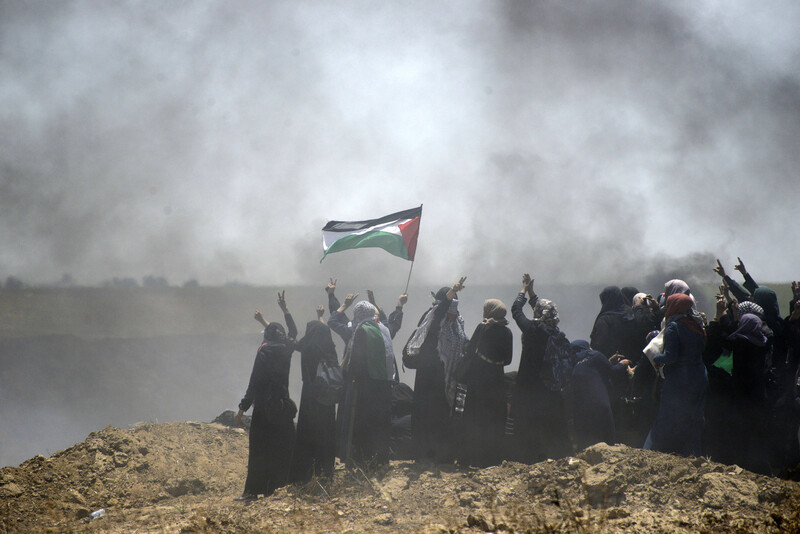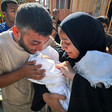Rights and Accountability 18 May 2018

Palestinian women cheer next to the Gaza-Israel boundary fence east of Gaza City on 14 May.
ActiveStillsIsrael has generated global outrage by picking off demonstrators – holding flags, slingshots, stones and incendiary kites, using burning tires, mounds of sand and improvised gas masks as defenses against heavily fortified soldiers armed with US-made Remington M24 sniper rifles – during weeks of protest in Gaza.
Now Israel is trying to spin away the damage by claiming that many of those killed were members of Hamas, and therefore deserved to die.
But as international law experts and international officials have stressed, the political affiliation of those killed on Monday is irrelevant when it comes to the legality of Israel’s actions.
More than 100 Palestinians have been killed and thousands more injured during the Great March of Return protests. Only one Israeli, a soldier, has reportedly suffered an injury, a minor one, in the context of the protests.
The disparity in casualties – and the photos and videos showing Israeli forces firing on protesters, medics and journalists who pose no conceivable danger – speak for themselves.
As Amnesty International documented in recent weeks, “Eyewitness testimonies, video and photographic evidence suggest that many were deliberately killed or injured while posing no immediate threat to the Israeli soldiers.”In most of the fatal cases analyzed by Amnesty International prior to last Monday’s massacre, “victims were shot in the upper body, including the head and the chest, some from behind.”
Canadian emergency doctor Tarek Loubani told The Electronic Intifada Podcast he was shot in the leg when everything was quiet around him: “No burning tires, no smoke, no tear gas, nobody messing around in front of the buffer zone. Just a clearly marked medical team well away from everybody else.”
An hour later, a paramedic who was part of his team, and who had rescued Loubani, was himself shot and killed.
Gaza’s medical system – already on the brink of collapse before the influx of thousands of injuries comparable to that of a war situation – urgently requires millions of dollars worth of drugs and medical supplies, as well as additional emergency personnel, as a result of this new crisis.
“For many, especially those who lost a loved one, who will now suffer a permanent disability or who will need intensive rehabilitation, the impacts of recent violence will be felt for months and years to come,” United Nations humanitarian coordinator Jamie McGoldrick stated on Thursday.
Israel has meanwhile been triaging the damage done to its international standing. It too may feel the impact of the violence for years to come.
A top Israeli military spokesperson acknowledged its public relations disaster during a briefing with the Jewish Federations of North America this week.
The spokesperson granted that the crisis was borne of the deadly violence that Israel warned it was prepared and planning to use both before the launch of the Great March of Return on 30 March and before Monday’s protests.
Both the bloodshed and the global backlash against Israel were preventable and predictable.
Seeking to deflect calls for accountability, Israel’s professional spin doctors have been pushing a video clip in which Hamas official Salah Albardaweel claims 50 of those killed on Monday belonged to the Islamist group.
The video has proven a major PR coup for Israel.Israel’s military and political leadership have sought from the beginning to portray the Great March of Return as a Hamas stunt exploiting civilian protests as a cover for “terror” activities which pose an existential threat to Israeli communities near the Gaza boundary.
Israel seeks to obscure the reality that the Great March of Return is a popular mobilization that includes the participation and leadership of Palestinians of all political stripes who seek an end to the siege and to exercise their right to return to lands just over Gaza’s boundary from which their families were expelled 70 years ago.
Seven of Monday’s fatalities were children.Several of those killed on Monday were buried in Hamas’ green flag, but not all. Fadi Abu Salmi, a double amputee, was shrouded with the flag of Islamic Jihad. Ahmad al-Adaini was buried in the flag of the leftist Popular Front for the Liberation of Palestine.
This was a point made by veteran French-Israeli journalist Charles Enderlin.
“On the Palestinian side, Hamas is presenting itself as victorious, that is to say it has annexed the dead, who most probably overwhelmingly did not belong to Hamas,” Enderlin told French television on Thursday. “Moreover, we did not see many Hamas flags during these demonstrations.”“Doesn’t change the rules”
Whether or not Albardaweel sought to inflate Hamas’ role in the protests, the political affiliation of those killed on Monday is irrelevant when it comes to the legality of Israel’s actions.
“It doesn’t matter whether the victims were members of Hamas or not,” Human Rights Watch director Kenneth Roth stated on Thursday.
“Israeli snipers, entrenched behind two substantial fences, had no right to use lethal force … against anyone unless as a last resort to stop an imminent lethal threat.”
Calling the dead “ ‘terrorists’ doesn’t change the rules,” Roth added.
“This wasn’t a war where combatants were shooting at each other. It was a protest, where law enforcement rules apply.”
This is a central claim by human rights groups regarding Israel’s conduct more generally: that irrespective of the political affiliation of any of the organizers or participants, the demonstrations along Gaza’s eastern perimeter are a civilian matter of law enforcement governed by the framework of international human rights law.
Israel claims the Gaza protests and its crackdown on them are “part of the armed conflict between the Hamas terrorist organization and Israel.”
It prepared for the demonstrations “as it would for a military operation,” according to Al Mezan and Adalah, two Palestinian rights groups petitioning the Israeli high court over the use of lethal force against Gaza protesters.
Israel “invents” law
In response to the challenge from the two Palestinian organizations, as well as another petition submitted by several other human rights groups, the Israeli government told the high court: “Hamas has been leading a new tactic of terrorist activity under the cover of ‘national commemoration events’ and ‘popular protests.’”
The Israeli government claims, as summarized by Al Mezan and Adalah, “that the careful planning of the events included the use of tire-burning allegedly to conceal attempts to infiltrate Israel, and the use of Molotov cocktails to damage the border fence and the Israeli military.”
The state argues that the makeup of the protests “were unusual in their size and in the intensity of their threat,” “occasionally” posing a threat to Israeli civilians.
Israel says that its forces were prepared for a massive breach of the boundary fence and “execution of attacks by terrorist cells,” and that the threat “may be caused by a single person or a crowd.”
Thus Israel argues that “the legal framework that regulates the opening of fire is the laws of warfare,” or international humanitarian law.
It claims to be operating from a hybrid of international human rights law and international humanitarian law, stating: “The complex nature of the events require, within the laws of warfare, distinction between the opening of fire within a paradigm of hostilities … and the opening of fire within a paradigm of law enforcement.”
Adalah and Al Mezan counter that such a paradigm “does not exist as an established body of law and has been invented by Israel in an attempt to justify greater leeway to use lethal fire than provided for in the regular paradigm of law enforcement.”
Eliav Lieblich of the Tel Aviv University law school has written that “the international legal source” for this paradigm put forth by the state “is unclear,” adding that “the very few sources cited by the government do not support its existence.”
One apparent source, the International Committee of the Red Cross, has slammed Israel for distorting a Red Cross legal report in order to justify its open-fire policy.
On Monday, the Tel Aviv newspaper Haaretz reported that the ICRC “strongly disagreed” with Israel’s interpretation of its legal analysis and had “forwarded its reservations to the Israeli authorities.”
“Completely baseless”
Israeli human rights lawyer Michael Sfard told Haaretz that “the huge number of casualties we have seen in recent weeks is a direct result of [Israel’s] legal thesis, which is completely baseless.”
He added: “It contradicts the most fundamental principles of laws governing the use of force, which adhere to the formula that endangering the lives of civilians can only be done to defend life – and nothing else.”
Sfard is among the lawyers representing human rights groups petitioning the high court, the first major review of the Israeli military’s classified open-fire regulations in decades.
“Diplomacy, external pressure and internal moral backbone have all failed here, and I hope the judiciary will not,” Sfard said.
But Israel’s high court has long championed policies towards Palestinians that violate international law.
Tel Aviv University’s Lieblich points out that “The court refrained from making any decision before the tragic events of 14 May, and a final decision might be rendered only after this particular episode of violence ends.”
UN votes for international investigation
Israel’s ambassador stated during a special session of the United Nations Human Rights Council on Friday that “The loss of life could have been avoided had Hamas refrained from sending terrorists to attack Israel under the cover of the riots, while exploiting its own civilian population as human shields.”
“It is Israel, certainly not Hamas, which makes a real effort to minimize casualties among Palestinian civilians,” Aviva Raz Shechter stated.
Israel’s argument failed to persuade the Human Rights Council against adopting a resolution to establish an international commission of inquiry into recent events in Gaza.
Only two countries – the US and Australia – voted against the measure. Fourteen others abstained, including countries like the UK which have called for independent inquiries into the killing of unarmed demonstrators in Gaza. Twenty-nine states voted in favor.
Dozens of human rights groups and civil society organizations had urged the Human Rights Council to launch an inquiry ahead of the special session. “The Israeli judicial system has demonstrated that it is unable and unwilling to ensure accountability for such serious crimes according to international standards,” nearly 100 groups stated earlier in the week. Meanwhile the office of the prosecutor of the International Criminal Court expressed “grave concern” over the deteriorating situation in Gaza on Wednesday.The court launched a preliminary examination into potential war crimes in the occupied West Bank and Gaza Strip in 2015.
“Any new alleged crime committed in the context of the situation in Palestine may be subjected to the office’s legal scrutiny,” the prosecutor stated. “This applies to the events of 14 May 2018 and to any future incident.”
Tags
- Great March of Return
- Jamie McGoldrick
- Hamas
- Fadi Hassan Salman Abu Salmi
- Ahmad al-Adaini
- Salah Albardaweel
- Kenneth Roth
- Human Rights Watch
- international humanitarian law
- international human rights law
- Al Mezan
- Adalah
- israeli high court
- Eliav Lieblich
- Michael Sfard
- UN Human Rights Council
- International Criminal Court
- Charles Enderlin
- Amnesty International
- Tarek Loubani
- International Committee of the Red Cross






Comments
Massacres of Palestinians
Permalink Patricia Toomey replied on
When Palestine became the sacrifice for the state of Israel, the UN was mandated to protect the occupied territory. Instead, the UN allowed Israel to annex the entire country. The UN was the prison guard that allowed the prisoners to be abused and tortured and in return, the UN recieved BLOOD money from the US. The UN was an honest world government until the US begin to blackmail & extort the leaders who were against the Iraq war. The US needed to take the legitimacy out and put hypocritical in and make the UN afraid to do their job.
too true
Permalink John Costello replied on
The UN was created by great powers to protect humankind from itself, clearly with the most noble intentions. Unfortunately, in writing up its bylaws, included was the reminder that the UN was created by great powers necessitating, of course, their veto power.
It's a bit like nukular weaponry; and it's a God damn good thing we got 'em.
Or, like taking an explosive situation and magnifying it.
It seems like it should have worked, doesn't it? Oh well, maybe another shot in the head will get us going in the right direction.